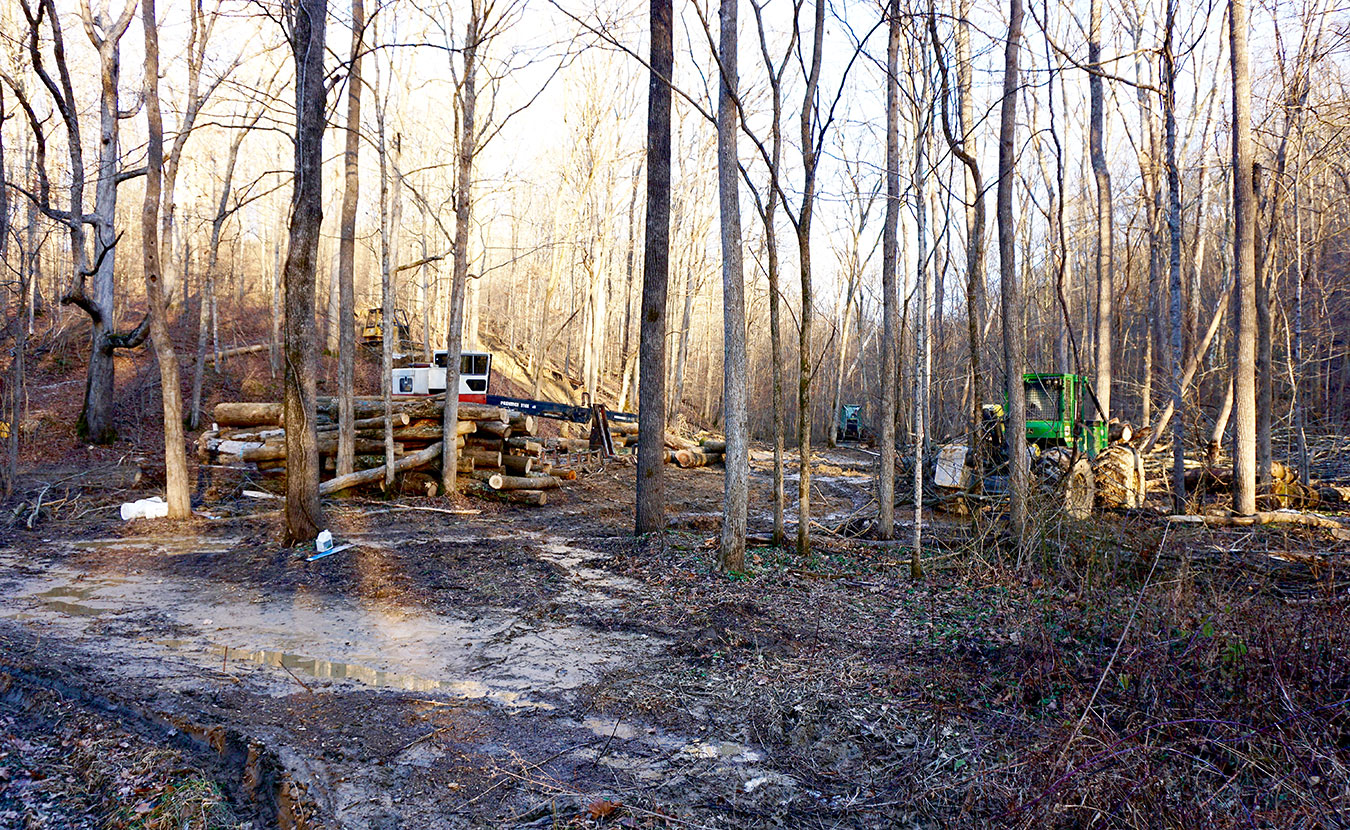A hiking trail can be many things to many people. It can be a way to get from one place to another. An avenue for recreation. Or a symbol of protection, indicative of the value we place on the natural world. It can also be a path to better health — both mental and physical — and a place to commune with like-minded friends.
I’ve lived in Indiana intermittently since 2007, but more often adventured on trails farther afield. Recently, I’ve made an earnest effort to better engage with my home trails of Indiana. They have a subtle beauty that has a way of surprising you the more time you spend on them. I’ve come to deeply appreciate the natural beauty of our native forests over the last few years. But last year, as I undertook a multimonth project on the Tecumseh Trail, I was saddened by the destruction I encountered in our state forests. But first, let me explain how this adventure began.
Planning
My initial idea for the Tecumseh Trail project came last summer, after I fastpacked Indiana’s longest point-to-point hiking trail, the 48-mile Knobstone Trail in southern Indiana (with Michael Waterford, who wrote about the experience here). Having enjoyed the Knobstone so much, I decided to tackle the Tecumseh Trail, a 42-mile point-to-point route — which meanders southeast from Morgan County, through Monroe County, and into Brown County — in multiple styles. The project I envisioned would take me through three different adventures on the Tecumseh Trail over the course of several months.
First, as summer waned, I would thru-hike the route with a group of friends. Next, in the brilliant fall colors of late October, I would race the Tecumseh Trail Marathon, which covers only 26.2 miles of the route, of course. Finally, in winter, I would thru-run the entire route in one day. By covering the trail multiple times in relatively close succession, I would intimately learn the nuances of its terrain while also taking in its scenic variety through the seasons.
The Tecumseh Trail was designed and built between 1998 and 2001 by the Hoosier Hiker’s Council. Along with the Knobstone Trail, it offers some of the best multiday backpacking in Indiana. The trails are also well suited to shorter day hikes. (The HHC provides a comprehensive guide to hiking the trail on its website here.) Tecumseh’s 42 miles begin from the trail’s northern terminus at Morgan-Monroe State Forest Headquarters. The route first follows the park’s Low Gap Trail in a rough “U” shape, winding past the aptly named Rock Shelter — a unique and imposing outcrop that provides a good snack stop.

A sunny ridgeline along Flaherty’s favorite section of the Tecumseh Trail in the southern section of Yellowwood State Forest. | Courtesy photo
The trail then meanders east and south, past Bear Lake, atop ridgelines, and along creeks until it crosses State Road 45 and Beanblossom Creek. It then climbs to the trail’s halfway point at the summit of Indian Hill. From there, the trail heads south to Lanam Ridge and Dubois Ridge before gradually descending to the northern end of Yellowwood Lake.
After traversing the western shore of the lake and ascending the steep and cheesily named High King Tail, the trail continues south across State Road 46 for a final seven miles in the southern section of Yellowwood State Forest. This section of the trail is my favorite, as it is fairly remote and traverses several beautiful ridgelines. (A full map and GPS data of the trail from my thru-run can be viewed here.)
Execution
My first adventure, the thru-hike, was an opportunity to scout the trail and enjoy it at a relatively leisurely pace with friends. The woods were still in full bloom, a sea of green with only the occasional vista. Unlike the Knobstone Trail, where backcountry camping is allowed, one can camp only in designated sites on the Tecumseh Trail. This creates a slight logistical challenge, as one’s daily mileage and camping locations need to be well planned. I charted a three-day thru-hike, covering roughly 14 miles a day. This schedule would take our group from the Morgan-Monroe Headquarters to the Foxes Den Shelter on day one. Day two would see us to the northern end of Yellowwood Lake, where camping is allowed in the open field for a small fee.
Our group consisted of nine hikers, seven of whom had never undertaken a multiday backpacking trip. In the end, only two of us opted for the full three days, while the others cut their hike at Yellowwood Lake after a rugged 28 miles in two days. For most, this was a significant challenge that left them tired, yet feeling accomplished and satisfied, without moving into the realm of the miserable.
After camping at the lake, my friend Ted and I completed the full route the next day, arriving at the southern terminus at Panther Creek by midafternoon. An odd nuance of the Tecumseh Trail is that it doesn’t end at a trailhead, but rather at a creek in the middle of the woods. From there, one can either scramble up an overgrown trail to Horse Trail D in Hoosier National Forest or hike two miles in reverse back to Crooked Creek Road. We chose the latter, hiking the two miles out to our car before driving to Nashville for a much-anticipated reward meal at Big Woods Brewing Co.
Next up in my Tecumseh project was the Tecumseh Trail Marathon, one of Indiana’s more popular trail races.
Despite being run on the last weekend of October, temperatures on race day reached a stifling 80 degrees. I had targeted the Tecumseh race with a course record in mind, which would require running under 2 hours, 58 minutes. I aggressively chased the mark, and despite flagging in the race’s latter miles as temperatures climbed, I narrowly dipped under the old standard by six seconds. (A more detailed account of my day and the Tecumseh Trail Marathon can be found here.)
While it might seem to an outside observer that racing as fast as one can isn’t the best way to experience a trail, I submit that it is a worthy endeavor that allows one to see a trail through a different lens. Every subtle variation in terrain — the grade of the trail, the height of roots or the slope of rocks, the dampness and slickness of the crushed leaves underfoot — becomes greatly magnified as you reach the limits of your endurance. To me, racing is (among other things) simply one more way to enjoy and appreciate nature.
The final adventure in my Tecumseh trio came two days after Christmas. Despite mild post-holiday food lethargy, I was excited for this final chapter. I’d be rejoining my friend Ted along with his brother-in-law, Joe, who was visiting from Oregon. Joe planned to complete the full run with me, while Ted would join us for the first 20 miles to Indian Hill before providing crew support for the trail’s back half.
Running a trail instead of racing it is actually quite a different experience. The pace is more relaxed, for one. It roughly splits the difference between a race and a hike. Covering 42 miles, I still become rather exhausted, of course, but I’m not on the edge of my abilities. I can take more time to stop and enjoy the view. On our run, we also took the luxury of stopping for meals and snacks throughout the day, spending nearly 9 hours on the trail but only 7 hours and 20 minutes of total running time.
Winter is my favorite time to run or hike the trails in Indiana. While all seasons hold their own allure, winter is unique because everything opens up visually. The Knobstone Escarpment, a prominent ridge running from near Louisville to the area east of Bloomington, is the defining geologic feature of southern Indiana. It is punctuated by steep knobs and ravines, and the topography is incredibly beautiful and interesting. Each ridge and hollow seems to have a personality all its own, and winter is the best time to explore and view the unique shapes of these features.
Despite sloppy, wet trails following several days of rain, we were blessed with a bluebird day. Cool and crisp, it couldn’t have been much better for running. As we neared the end of the trail, dusk was arriving. We descended from a web of ridges to the Crooked Creek Road crossing with two miles remaining, eager for our journey’s conclusion. But there, we were greeted with a disheartening sight.
Destruction
Where once there was a trailhead and small carpark for trail users, massive logging trucks had destroyed the trail. We tried to trace the switchback climb from Crooked Creek Road, but the hillside was virtually unrecognizable. Huge equipment had cut across the side of the slope, wiping out the trail and the trees that had once marked it, and leaving piles of scrap wood crisscrossing the slope. We sank into the soft mud of the grooved tire tracks, picking our way up the hill.

Instead of singletrack trail, Flaherty encountered rutted tire tracks and new clearings near the end of the Tecumseh Trail. | Courtesy photo
Once we gained the ridge, we saw the newly clear-cut slope where the trucks had been going. A few minutes later, we completed the Tecumseh Trail with rather mixed feelings — happy with our accomplishment but saddened by the destruction we encountered.
Multiple official statements from the Indiana Department of Natural Resources, including some signs along the Tecumseh Trail, insist on the sustainability of the logging (euphemistically, “forest management”). This is a complex issue and beyond the scope of this article, but I must say it’s hard to truly believe the DNR’s claims when one encounters scenes like we did (or like the recent clearcutting of slopes on the west side of Yellowwood Lake). The visible destruction feels wholly incompatible with the very notion of sustainability.
The Indiana Forest Alliance, which probably does the most of any group to advocate for protecting our public land in Indiana, has cataloged the widespread use of devastating logging practices on its website. The Indiana Daily Student also produced an excellent piece in December about deforestation and logging in Indiana, including the merits of select cutting versus clearcutting.
Reasonable minds can differ on how exactly to best manage our forests, of course. But one could be forgiven for doubting the DNR’s ostensibly virtuous environmental intentions in a deeply conservative state, especially given the extractivist and anti-environment agenda pushed by all levels of the Republican Party in recent years.
When it comes to publicly owned land, Indiana ranks near the bottom in the United States (by percentage), which makes protecting what we have all the more important. As the Indiana Forest Alliance’s mission puts it: Indiana’s native hardwood forests should be for the enjoyment of all. And that includes the few long hiking trails we have, like the Tecumseh.
A trail can be many things to many people. It can also be destroyed. Let’s hope — for our sake and the sake of future Hoosiers — that the Tecumseh Trail and our state forests will survive the current onslaught. They’re well worth fighting for.




No Replies to "A Hike on the Tecumseh Trail Now Ends in Destruction"